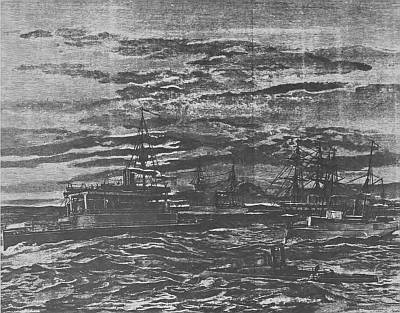- Author
- Webb, P
- Subjects
- None noted
- Tags
-
- RAN Ships
- None noted.
- Publication
- August 1972 edition of the Naval Historical Review (all rights reserved)
Mr. Webb is secretary of the Victorian Chapter of the Naval Historical Society of Australia. He is a well known artist/draughtsman specialising in ships’ drawings and plans.

VICTORIA WAS SEPARATED from the mother colony of New South Wales in 1851, and was fast to realise that her very existence could stand in jeopardy without a navy. Gold discoveries drew thousands of people from all over the world to Victoria by mid 1852. There was no way for local authorities to enforce control over the port waters so an appeal was made to the Imperial Government for an armed vessel to be stationed in Port Phillip. HMS Electra under Captain Morris arrived at Williamstown in April 1853.
Electra was inadequate, and Sir Charles Hotham applied for a vessel similar to HMS Devastation to be sent out at Imperial Government expense. This request was not complied with, so Victoria ordered a screw sloop of war from the Limehouse yard of Young Son & Magnay. This first war vessel built to the order of any British colony cost $76,000, was of 580 tons, and had a speed of 13 knots. Commander William Norman brought her out and anchored her off the site of the dockyard on 31st May 1856.

Principal employment of HMCS Victoria was rendering assistance to shipwrecked mariners, carrying out coastal surveys, storing lighthouses, and as a water police ship. She repatriated stranded diggers from the abortive Port Curtis goldrush in 1858 and searched Northern Australian waters for Burke and Wills in 1861. Her declining years were spent as a general purpose hack and she was broken up at Williamstown in 1896.
Victoria went to war once only, when she operated as a despatch vessel attached to HMS Pelorus in New Zealand waters during the Taranaki Rebellion. She landed a party of her seamen who constructed a redoubt under heavy fire. Her armament at the time comprised a 32 pdr. pivot gun forward and aft, two similar long guns broadside, and four short 32 pdrs.
War in the Crimea caused local panic with fears of invasion by a cruising Russian squadron. In anticipation of a war, fortifications were set up as a massive semicircular redoubt enclosing portion of the land now occupied by the dockyard. These works, completed in 1855, were demolished six years later. The parapet was seven feet high, eighteen feet wide at the summit and twenty-six feet at the base. Chief Harbour Master, Captain Charles Ferguson, raised an artillery force to man the defences and on 8th April 1856 this became the Williamstown Division of the Victoria Marine Artillery Corps. Williamstown and Port Melbourne were charged with the task of raising the Victoria Naval Brigade in 1859. Manning guns of the port blockship Sir Harry Smith was their first task.
The Colonial Naval Defence Act of 1865 laid down a definite policy by which colonies could provide, maintain, and use their own vessels of war. Permanent naval forces could be raised and volunteers enlisted for the Royal Naval Reserve. After implementation of the Act, vessels of the Victorian Navy were titled HMVS instead of HM Colonial Ships, although official correspondence shows occasional lapses until the hoisting of the Victoria Ensign.
George Verdon (later Sir) was sent to consult the Imperial Government on naval defence matters for Victoria in 1866. Verdon represented Williamstown in Parliament. He obtained from the British Government the old wooden battleship Nelson for use as a naval training ship, and $200,000 towards the cost of the ironclad turret ship Cerberus. Nelson was laid down in 1805 as the first ship of the line built in England after the Battle of Trafalgar. She was launched in 1814, too late to take part in the Napoleonic Wars, and as peace brought the usual drastic reduction in naval forces the vessel spent most of her life laid up, until she was cut down to a twodecker and fitted with an auxiliary steam engine and screw. Originally she carried 126 guns and a crew of 875. She was reduced to a single-decker at Williamstown Dockyard in 1881.
Captain Charles Payne went to England with Verdon and brought back Nelson. He remained in charge of the vessel until the death of Captain Ferguson in 1870 when he was appointed Chief Harbour Master. Nelson became a training ship for ‘. . . waifs and strays who had become a burden on the colony either by death of parents or desertion of them . . .’ soon after she made port in February 1868. Average annual number borne on her books was 350 boys, controlled by 36 officers and men.
Nelson was used for a time as a store ship lying off Fishermen’s Bend. She was sold at auction by the British Government in 1898, to Mr. B. Einerson of Sydney for $4,800. She became a Union Steamship Co. coal hulk at Sydney in 1901. She was towed to Beauty Point on the Tamar in 1908, and later to Hobart, where she went to the breakers in 1924. The remains were fired at Shag Bay to secure some tons of gunmetal and bronze fastenings.
The national flag granted to the Colony of Victoria was officially inaugurated in 1870 when it was broken out on the mainmast of HMVS Nelson. It incorporated the Union Flag in the upper left quadrant and the Southern Cross on an azure field. The new mercantile Red Ensign was flown from the mizzen.




